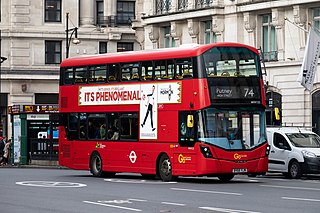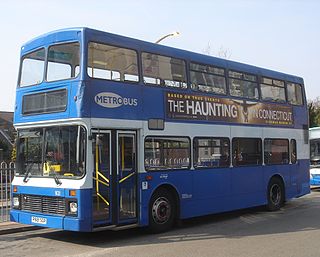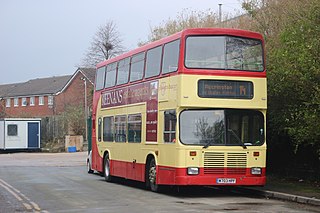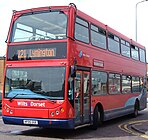
The Volvo B7TL is a low-floor double-decker bus chassis which was launched in 1999 and replaced the 2-axle version of the Volvo Olympian. It was built as the British bus operators seemed hesitant to purchase the B7L double decker with a long rear overhang.

The Volvo B7L is a fully low floor single-decker bus, double-decker bus and articulated bus chassis with a rear engine mounted vertically on the left of the rear overhang. It was built as a replacement for the Volvo B10L, and the Volvo Olympian. It was used as both a single-decker bus and a double-decker bus chassis largely in Continental Europe.

The Alexander ALX400 was a 2-axle double-decker bus body built by Walter Alexander Coachbuilders. It was one of the ALX-series bodywork, all of which featured the same designs on the front and rear panels that were originally designed for the new generation of mainly low-floor bus chassis produced since the late 1990s.

The Plaxton President was a low floor double-decker bus body built at Northern Counties plant in Wigan, England and branded as a Plaxton product for its main production run. It was first unveiled in 1997 on the longitudinal Volvo B7L chassis and later built between 1998 and 2005 following a body redesign. When it became part of TransBus International, the body was sold under the TransBus name. The President was built on the Dennis/TransBus Trident, the DAF DB250 and the Volvo B7TL chassis.

The Wright Eclipse Gemini is a low-floor double-decker bus body that was built by Wrightbus since 2001, based on the single-deck Wright Eclipse design. The second-generation Eclipse Gemini 2 was launched in 2009, followed by the third-generation Gemini 3 in 2013. Additionally, the body was available on Volvo Super Olympian chassis in Hong Kong between 2003 and 2005, marketed as the Wright Explorer.

East Lancashire Coachbuilders Limited was a manufacturer of bus bodies and carriages founded in 1934 in Blackburn, Lancashire, England. The company went into administration for a short while in August 2007, before being bought by Darwen Group and performed a reverse takeover with Optare when its parent purchased the company in 2008 and its site and business was later closed in 2012.

The Volvo Olympian was a rear-engined 2-axle and 3-axle double decker bus chassis manufactured by Volvo at its Irvine, Scotland factory. The first was built in 1992 and entered production in March 1993, replacing the Leyland Olympian.

The East Lancs OmniTown was a low-floor midibus body sold in the United Kingdom by East Lancs and Scania. It used the Scania N94UB chassis, which is the single-decker version of the N94UD double-decker chassis, with East Lancashire Coachbuilders bodywork. It is sometimes mistakenly referred to as the OmniTown chassis. The confusion concerning the chassis, and indeed the buses, arises due to the complexity of the OmniTown's and other Scania products' histories.

The East Lancs Myllennium was a type of single-decker bus body manufactured by East Lancashire Coachbuilders on DAF SB220, Dennis Dart SLF, MAN 14.220 and Scania N94UB chassis. It was superseded by the East Lancs Esteem in 2006.

The East Lancs Lolyne is a type of double-decker bus body built by East Lancs. It is the double-decker version of the Spryte. It continued the long line of 'misspelt' names which continued until the Scania OmniDekka. It was built on the Dennis Trident 2 twin-axle low-floor bus chassis and it can be built as either a closed top bus or an open-top bus.

The East Lancs Nordic is a type of low-floor double-decker bus body built by East Lancashire Coachbuilders. It was built on tri-axle double-decker Volvo B7L chassis, with a length of 12 metres and a seating capacity of up to 95 passengers. The Nordic body design is based on an elongated version of the East Lancs Vyking body, with the name "Nordic" being derived from the chassis being built by a company from Sweden. The bus was later superseded by its Myllennium counterpart in 2005.

The East Lancs Spryte was a low floor single-decker bus body built by East Lancashire Coachbuilders. It was designed to body the Dennis Dart SLF chassis, but a handful have been built on others, for example, the Volvo B6LE. Mechanically and visually, it is the single-decker version of the East Lancs Lolyne.

The East Lancs EL2000 is a type of single-decker bus body built on a wide variety of bus chassis by East Lancashire Coachbuilders.

The East Lancs E Type is a type of double-deck bus body built on different chassis by East Lancashire Coachbuilders.

The East Lancs 1984-style double-deck body is a type of double-decker bus body with a step-entrance, built on several different chassis by East Lancashire Coachbuilders in England.

The East Lancs Myllennium Lowlander is the type of double-decker bus body built on the DAF/VDL DB250 chassis by East Lancashire Coachbuilders. The name "Lowlander" was derived from the chassis being built by a company from The Netherlands.

The Optare Esteem was a low-floor single-decker bus body manufactured by East Lancashire Coachbuilders, Darwen East Lancs and Optare between 2006 and 2009 on Scania N94UB, Scania N230UB, Volvo B7RLE, MAN 12.240, Alexander Dennis Dart SLF, Alexander Dennis Enviro200 Dart and Alexander Dennis Enviro300 chassis.

The Optare Olympus is a double-decker bus built by Optare, East Lancs and Darwen. It could be built as a body available on Alexander Dennis Enviro400, Volvo B9TL or Scania N230UD/N270UD chassis with the 2-axle and 3-axle variants. It is the double-decker equivalent of the Optare Esteem. Some 3-axle Olympus buses were built.

The East Lancs OmniDekka is a double-decker bus built for sale in the UK market, introduced by East Lancashire Coachbuilders in 2003. Originally built on Scania N94UD chassis at Euro 3, and later Scania N230UD and N270UD at Euro 4 and Euro 5, the bodywork consists of a modified East Lancs Myllennium double decker, but with the standard front end cowl and windscreen replaced with that of Scania's own integral OmniCity. Through takeovers of East Lancs, production of the OmniDekka was latterly carried out by the Darwen Group and finally Optare before ceasing in 2011.






















